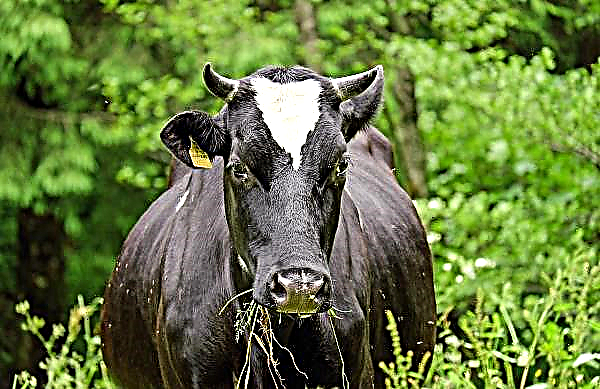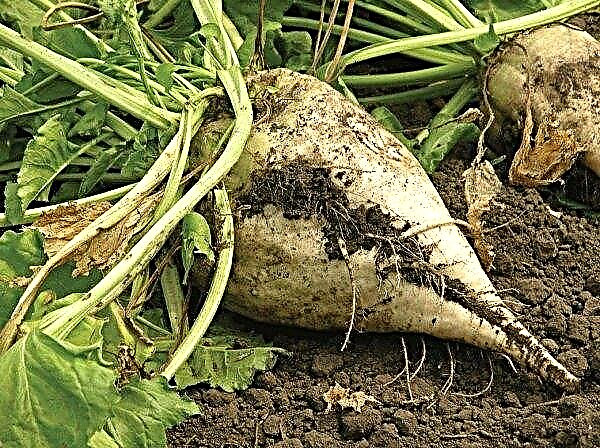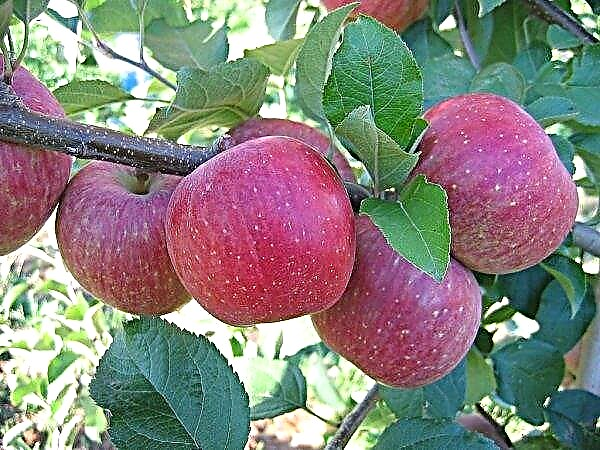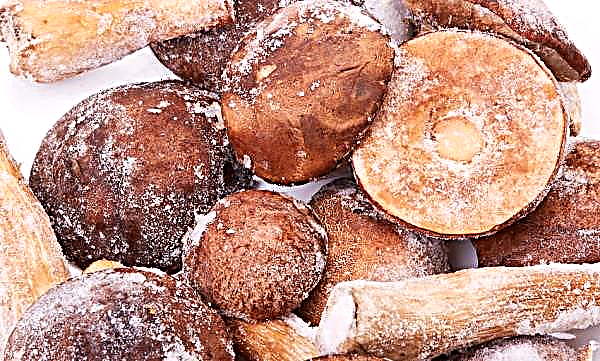Among the varieties of carrots that are resistant to diseases and unpretentious in care, Berlicum Royal occupies a special place. About varietal features and rules for growing crops, read below.
History of the variety
Berlikum Royal was received by Dutch breeders. Refers to the Berlicum variety. In Russia, it is zoned in the Central Black Earth region. However, due to its high adaptive ability, it is one of the most common in all regions except the northern ones. In cold areas, summer is short, so late ripe fruits do not have time to ripen.
Did you know? The first cultivated varieties of carrots were purple, less common were white and yellow root vegetables. The usual orange vegetables were bred artificially.
Description and characteristic
The culture is very popular due to its quality indicators. It has a good keeping quality and is universal in use.
Appearance and productivity
Late-ripening variety ripens in 110-130 days. The fruit is about 22 cm long and weighs 120–190 g. It resembles a cone with a slightly blunt tip. It is painted in bright orange color. The flesh on the cut is the same color. Very juicy, crispy.

Productivity is high. From 1 m², you can collect from 5 to 8 kg of carrots. The fruits are well stored. The consumer period continues until spring.
Taste qualities
Regarding the taste, the culture was praised. The fruit is sweet and very juicy.
Grade stability
Berlikum Royal is resistant to Fusarium and Carrot Fly. Shooting and flowering are not characteristic of culture. The plant takes root perfectly in any climatic conditions, even winter sowing is possible. The fruits are not resistant to cracking, so when growing you need to be careful with watering.
Did you know? Previously in Germany, “soldier's coffee” was made from roasted carrot fruit.
Advantages and disadvantages of the variety
The main difference from other varieties is the increased content of carotene in the pulp of the fruit. Per 100 g of product, 21 mg of carotene falls, while other varieties contain mainly up to 9 mg.
Before planting the variety on the site, you need to familiarize yourself with the advantages and disadvantages of the culture in order to be able to create the most favorable conditions conducive to increasing yields and improving the quality of the final product.

- Among the advantages of the variety can be noted:
- high taste;
- the universality of the use of fruits - they can be eaten fresh, used in diet, for processing into juice and mashed potatoes;
- long shelf life of the crop;
- unpretentiousness in leaving;
- excellent adaptive abilities;
- high resistance to fungal diseases.
The only disadvantage of this culture is its poor cracking resistance. But it can be fixed with the help of agricultural techniques.
Features of outdoor cultivation and care
To get a good crop, you need to create optimal conditions for the crop. In addition, it is necessary to choose and prepare planting material correctly.
Optimal terms and conditions for sowing
Sow carrots of this variety begin in late March - early April. The main thing is that the ambient temperature is set within + 15 ° C, and the soil warms up to + 7 ° C. Before winter, seeds are sown in late October - early November. But it is better to carry out such crops only in the southern regions.
In the central zone, it is better to sow carrots in the greenhouse for the winter. The variety bears fruit well even in unheated greenhouses made of polycarbonate. The landing area should be well-lit. Carrots do not develop well in shading.
Preparation and scheme of planting seeds
Seeds of the crop in question are sold:
- in bulk - between small grains it is difficult to maintain an interval of 3-4 cm, so after emergence, seedlings have to be thinned out;
- on tape - a very convenient modification, the seeds are processed with growth accelerators and fixed on the tape at a certain distance, so the only thing to do is put it in a hole and pour it well with water, and after germination it will not be necessary to thin out;
- glazed - the seed is treated with special substances that make the culture more resistant to adverse factors, in addition, due to the glaze, the seeds become larger, and when planting between them it is easier to observe the interval.

Seeds on the tape and in the glaze do not require pre-treatment. Loose planting material before planting should be soaked for 4-6 hours in a solution of "Epina". 2 drops of liquid are added to 100 ml of room temperature water. The plot is being prepared since autumn. First, it is dug up on a bayonet shovel, then the soil is disinfected with a 3% solution of Bordeaux fluid.
After a week, 10 kg of fresh manure and 200 g of superphosphate are added to each m². After that, they again dig the site. If the soil is heavy enough, then 10 kg of sand and peat per m² are applied along with fertilizers.
In the spring, a month before planting, soil cultivation is again carried out. 10 kg of compost per 1 m² and 500 g of wood ash are introduced into the soil. The planting pattern recommended by the originators of the variety is 20 × 4 cm. The embedment depth is 1-2 cm.  At the planting stage, no more fertilizer is applied to the ground. 2-3 days before sowing, watering is carried out if the soil is not wet enough. Contribute 10 l of water per m². Preliminary, the site is leveled and furrows are made 1-2 cm deep. Seeds are placed in them and covered with a layer of soil.
At the planting stage, no more fertilizer is applied to the ground. 2-3 days before sowing, watering is carried out if the soil is not wet enough. Contribute 10 l of water per m². Preliminary, the site is leveled and furrows are made 1-2 cm deep. Seeds are placed in them and covered with a layer of soil.
Frequency of irrigation and fertilization
Watering carrots begins every 3 days from the moment the first sprouts appear. Water is poured through a watering can in the aisles. Consumption - 10 l / m². The liquid should not be cold. If the site is only spring water. It’s better to put it in a barrel and leave it in the garden under the sun. So in the evening the liquid will be warmed up to ambient temperature.

In the phase of formation of root crops, the interval between irrigation and water volumes should be increased. At the same time, 20 liters of water will be required per 1 m², and the interval between humidifications will be 6–10 days, depending on the weather. In mid-August, moisture levels gradually begin to decrease. 2 weeks before harvest, carrots are no longer watered at all.
The first top dressing is introduced in the phase of emergence of seedlings in parallel with irrigation. To 5 liters of water add 1 tbsp. l nitrofoski. To fertilize, a ditch 5 cm deep is dug in the central part of the aisles. Liquid is poured into it, and then it is buried. After 20 days, a solution of compost and wood ash can be added. To do this, add 1 tbsp to 5 liters of water. compost and 200 g of ash. They are applied to the soil in a similar way.
Important! During the vegetative growth of carrots, it is unacceptable to use fresh organics. It can be applied at least six months before sowing for digging.
Thinning and weed control
If sowing was carried out with loose seeds, after emergence, seedlings need to be thinned out, leaving a distance of 4 cm between the shoots. A little later, in the phase of root crop formation, the interval between plants should be increased to 8 cm.

A day after each irrigation, it is necessary to loosen the soil in the aisles to a depth of 5-8 cm with the simultaneous removal of weeds. When the interval between watering will be increased to 6-10 days, after loosening, it is advisable to mulch the soil with compost. This will save moisture in the soil and prevent the emergence of weeds, pests and the spread of diseases.
Major diseases and pests of the variety
This culture is highly resistant to diseases and pests, so additional processing with chemicals is not required. As a prophylaxis, all the above-described agro-technical methods are used.
Despite the high resistance to disease, if the humidity is too high, the fruits can be affected by various types of rot and powdery mildew. When such problems occur, it is necessary to remove the affected specimens from the site and the soil between the rows to be dusted with wood ash and foundationazole in a 1: 1 combination. Watering during the treatment period should be completely abolished and more attention should be paid to loosening the soil.
Harvesting and storage
Harvest carrots of this variety begin in the middle - end of September. Cleaning should be done in sunny weather. If there is a rainy season, it is better to harvest the crop well in advance or wait 4 days after it is finished, and then start digging.
Important! When storing, observe the rules of the fruit and vegetable neighborhood. Carrots do not tolerate the neighborhood with apples and other root crops.
After digging up the carrots are sorted. The damaged one is put aside for quick processing, the rest is placed in a well-ventilated place for a week to dry. Then the root crops are transferred to 2-layer wooden or plastic boxes. Store in a cool place at a temperature of + 6 ° C and relative humidity of 70%. Berlicom Royal carrot variety is perfect for cultivation in different climatic zones, except the northern ones. Plants are characterized by high productivity and unpretentious care.












